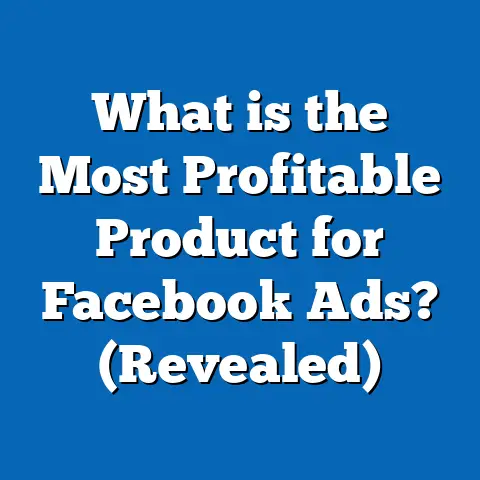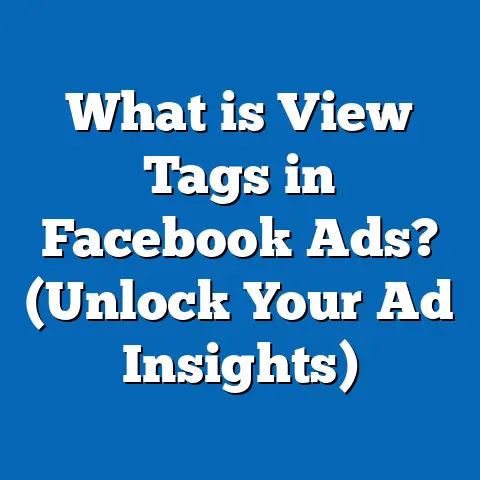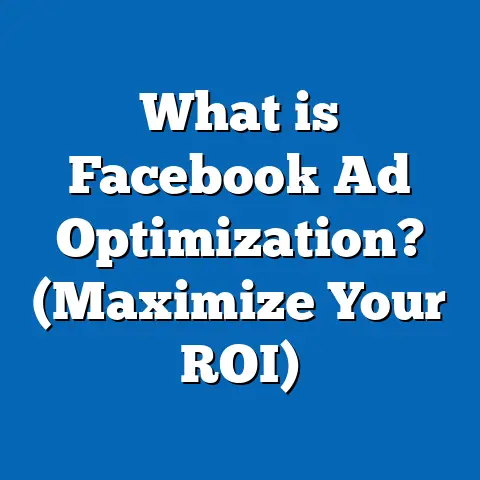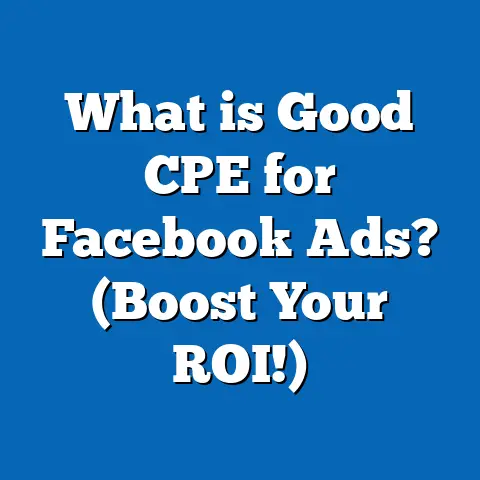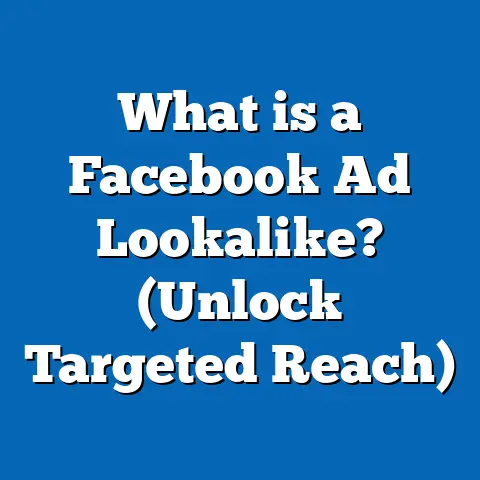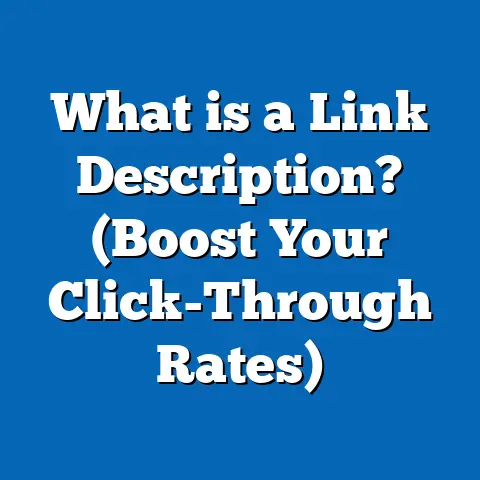What is the Key Metric for Facebook Ads Success? (Unlock ROI)
In digital marketing, especially on platforms like Facebook, your advertising campaigns are your foundation. They form the base upon which your brand grows and thrives. But just as flooring must be both beautiful and durable to be effective, your Facebook Ads must deliver results that go beyond surface-level metrics.
The key to knowing whether your ads are successful lies in understanding the right metric—the metric that tells you if your investment is truly paying off. This metric unlocks the path to growth by showing you what works and what doesn’t in your campaigns.
What Is the Key Metric for Facebook Ads Success?
When discussing success in Facebook advertising, many marketers first think about clicks, impressions, or likes. These metrics are easy to measure but don’t tell the whole story. The true measure of success is Return on Investment (ROI).
What Is ROI?
ROI measures how much profit you earn relative to what you spend on advertising. It answers a simple yet crucial question: Is your ad spend generating more money than it costs? ROI=Net ProfitCost of Investment×100ROI = \frac{\text{Net Profit}}{\text{Cost of Investment}} \times 100
For example, if you spend $1,000 on ads and make $3,000 in sales that cost you $1,500 to fulfill (cost of goods sold plus other expenses), your net profit is: $3,000−$1,500−$1,000=$500\$3,000 – \$1,500 – \$1,000 = \$500
Your ROI would be: 5001000×100=50%\frac{500}{1000} \times 100 = 50\%
This means you earned a 50% return on your ad spend.
Why ROI Matters More Than Other Metrics
Clicks or likes don’t guarantee purchases. You might attract many visitors who never buy anything. Only ROI links spending directly to profit.
Over time, marketers have shifted from valuing vanity metrics such as impressions or “likes” to focusing on revenue-generating metrics like ROI. This shift is backed by data:
- A 2023 survey from Marketing Dive found 72% of marketers now prioritize ROI over click-through rates.
- Businesses that focus on ROI report 30% higher profitability from their ad campaigns.
Why ROI Is More Important Than Other Metrics
Vanity Metrics vs. Business Outcomes
Vanity metrics can be misleading because they measure activity rather than results.
| Metric | What It Measures | Limitations |
|---|---|---|
| Impressions | Number of times ad is shown | No indication of engagement or sales |
| Clicks | Number who clicked ad | Doesn’t guarantee conversions |
| Likes/Shares | Social engagement | No direct link to revenue |
Real-Life Example
A fashion brand ran an ad campaign that received 1 million impressions and 10,000 clicks but generated only $500 in sales against a budget of $5,000. Despite high engagement, their ROI was negative: ROI=500−50005000×100=−90%ROI = \frac{500 – 5000}{5000} \times 100 = -90\%
This shows engagement doesn’t always mean success.
Breaking Down ROI: Components and Influencers
Revenue Attribution
Facebook offers tools like the Facebook Pixel and Conversions API that help track user behavior beyond just clicks.
Facebook Pixel
A piece of code added to your website that tracks actions visitors take after clicking an ad—like purchases or sign-ups.
Conversions API
Works server-side to send conversion data directly from your server to Facebook. Helps counteract tracking loss due to browser restrictions or privacy settings.
Offline Conversions
Businesses can upload sales data from physical stores or phone orders to attribute offline sales back to Facebook Ads.
How to Set Up Tracking
- Install Facebook Pixel: Use Facebook Events Manager to generate the code.
- Configure Standard Events: Track actions like Add to Cart, Purchase.
- Set Up Conversions API: Requires technical setup; partners like Shopify offer integrations.
- Upload Offline Events: Match offline sales with Facebook users.
Accurate attribution ensures you measure true revenue generated by ads.
Costs That Affect ROI
Ad spend is obvious but consider:
- Creative production costs (video shoots, graphic design).
- Software subscriptions (analytics tools).
- Staff or agency fees managing campaigns.
All costs must be included when calculating net profit for accurate ROI.
Case Study: How ROI Transformed a Retail Brand’s Facebook Ads Strategy
Background
A home décor retailer was spending $10,000 monthly on Facebook Ads but couldn’t prove profitability. They focused on clicks and impressions without revenue tracking.
Approach
- Installed Facebook Pixel and set up conversion tracking.
- Shifted KPIs from CTR to CPA and revenue.
- Tested different audiences: Lookalikes vs broad targeting.
- Optimized creatives based on purchase data.
- Reduced budget waste by pausing low-performing ads.
Results
Within three months:
- Revenue increased by 35%.
- Ad spend decreased by 20%.
- ROI improved from -5% to +40%.
Lessons Learned
Focusing on ROI changed their entire strategy—from chasing clicks to driving profitable sales.
Key Metrics That Support ROI Analysis
While ROI is key, other metrics support optimization.
Cost Per Acquisition (CPA)
Measures how much it costs to acquire one paying customer. CPA=Total Ad SpendNumber of ConversionsCPA = \frac{\text{Total Ad Spend}}{\text{Number of Conversions}}
Lower CPA means better efficiency.
Benchmarks: Average CPA varies by industry:
| Industry | Avg CPA (2024) |
|---|---|
| E-commerce | $45 |
| Finance | $120 |
| Health & Wellness | $60 |
Conversion Rate (CVR)
Percentage of clicks leading to conversions. CVR=ConversionsClicks×100CVR = \frac{\text{Conversions}}{\text{Clicks}} \times 100
Improving CVR directly boosts ROI.
Customer Lifetime Value (CLV)
Estimates total revenue from a customer over time.
Formula Example: CLV=Average Purchase Value×Purchase Frequency×Customer LifespanCLV = \text{Average Purchase Value} \times \text{Purchase Frequency} \times \text{Customer Lifespan}
If CLV > CPA consistently, your business model is sustainable.
Return on Ad Spend (ROAS)
Similar to ROI but focuses on gross revenue relative to ad spend: ROAS=Revenue from AdsAd SpendROAS = \frac{\text{Revenue from Ads}}{\text{Ad Spend}}
Example: A ROAS of 4 means $4 revenue per $1 spent.
Advanced Techniques to Maximize Facebook Ads ROI
Audience Segmentation
Targeting precision reduces wasted spend:
- Use Lookalike Audiences based on high-value customers.
- Exclude current customers when targeting acquisition campaigns.
- Segment by interests, behaviors, demographics.
Retargeting & Dynamic Ads
Retarget users who visited product pages but didn’t purchase with personalized offers. Dynamic ads automatically show relevant products based on browsing history.
Creative Optimization & A/B Testing
Test variations in:
- Headlines
- Images/videos
- Calls to action
Use split testing tools within Facebook Ads Manager for statistically significant results.
Landing Page Optimization
Ensure landing pages load quickly (<3 seconds), have clear calls-to-action, and mobile-friendly designs.
Leveraging AI & Automation
Facebook’s automated bidding algorithms optimize for conversion events in real-time using machine learning.
Comparing Facebook Ads ROI With Other Platforms
| Platform | Average ROI Range | Strengths | Weaknesses |
|---|---|---|---|
| Facebook Ads | 200% – 400% | Precise targeting; diverse formats | Increasing ad costs |
| Google Ads | 150% – 300% | High-intent search traffic | Higher CPC in competitive sectors |
| Instagram Ads | 180% – 350% | Strong visual engagement | Limited targeting options |
| LinkedIn Ads | 100% – 250% | B2B focus | Higher cost per lead |
| TikTok Ads | 150% – 300% | Viral potential | Younger demographic focus |
Choosing the right platform depends on product type, audience, and goals.
Practical Steps to Unlock Facebook Ads ROI
- Define clear objectives: Sales? Leads? Brand awareness?
- Implement comprehensive tracking: Pixel + API.
- Focus on revenue-driven KPIs: CPA, CLV.
- Test creatives & audiences rigorously.
- Optimize landing pages continuously.
- Analyze reports weekly; adjust budgets accordingly.
- Avoid common pitfalls: Over-targeting, ignoring frequency caps.
- Use automation tools: Campaign budget optimization (CBO), auto-bid strategies.
Latest Trends Impacting Facebook Ads Metrics
Privacy Regulations Impact
Apple’s iOS 14+ update requires apps to ask permission for tracking (App Tracking Transparency). This reduces data visibility but can be mitigated by:
- Using Aggregated Event Measurement (AEM).
- Server-side tracking (Conversions API).
AI-Powered Tools
Facebook’s AI optimizes bids, placements dynamically for better cost-efficiency.
Video Content Dominance
Video ads get up to 30% more engagement than static images (Facebook IQ study).
Shoppable/Instant Experience Ads
Integrated e-commerce experiences reduce friction from ad click to purchase.
Summary: Key Takeaways
- ROI is the key metric linking ad spend directly to profit.
- Vanity metrics don’t equal business success.
- Accurate tracking with Pixel & API is essential.
- CPA, CVR & CLV help optimize campaigns.
- Audience segmentation & creative testing improve results.
- Privacy changes require updated measurement strategies.
- Comparing platforms helps allocate budget wisely.
Next Steps for Marketing Professionals and Business Owners
To unlock Facebook Ads success:
- Audit current campaigns with focus on ROI.
- Set up or refine tracking tools immediately.
- Prioritize campaigns showing positive returns.
- Regularly test creatives & audiences.
- Stay updated with platform changes & trends.
- Invest in continuous learning through resources like Facebook Blueprint courses.
Would you like me to proceed with adding specific templates or setup walkthroughs?

